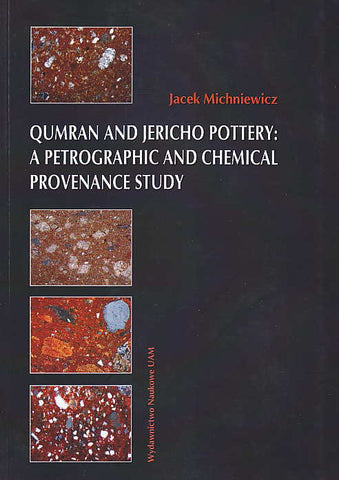Qumran and Jericho Pottery: a Petrographic and Chemical Provenance Study
29,99 $
ISBN: 978-83-232-2130-2
Description: softcover, (24x17cm), 168 pp., 66 figs
Condition: very good- (shelf damages of cover)
Weight: 435g.
Jacek Michniewicz, Qumran and Jericho Pottery: a Petrographic and Chemical Provenance Study, Adam Mickiewicz University Press, Poznan 2009
Acknowledgements
1. INTRODUCTION
1.1. Location of Qumran in the light of the geological structure of the region
1.2. What knowledge can be gained from petrographic and chemical investigations, and what are their limitations
1.3. Prior investigations
1.4. Analytical methods
1.5. Search for potential clay deposits and laboratory tests of the clay samples collected in the field
1.5.1. Hebron
1.5.2. En Gedi
1.5.3. Wadi Qumran
1.6. Experimental clay firing
2. OIL LAMPS FROM THE QUMRAN SITE AND THE JERICHO WINTER PALACES
2.1. Object of study
2.2. Results of petrographic examination
2.2.1. PETROGRAPHIC GROUP I (Foraminiferous Clay Group)
2.2.2. PETROGRAPHIC GROUP II (Rich Clay - Calcareous Sand Group)
2.2.3. PETROGRAPHIC GROUP III (Rich Clay - Quartz Sand Group)
2.2.4. LAMPS NOT ASSIGNED TO ANY OF THE GROUPS
2.3. Chemical data and mathematical interpretation
2.3.1. Principal components analysis
2.3.2. Spanning tree
2.4. Comparison of the results of geochemical analyses with those of petrographic observations
2.5. Summing up
3. JERICHO - COMMON CERAMICS FROM HASMONEAN AND HERODIAN PALACES
3.1. Object of study
3.2. Petrography
3.2.1. PETROGRAPHIC GROUP I (Foraminiferous Clay Group)
3.2.2. PETROGRAPHIC GROUP II (Rich Clay - Calcareous Sand Group)
3.2.3. PETROGRAPHIC GROUP III (Rich Clay - Quartz Sand Group)
3.2.4. PETROGRAPHIC GROUP IV (Terra Rossa Group)
3.3. Results of chemical analyses and their mathematical interpretation
3.3.1. Principal components analysis
3.4. Summing up
4. QUMRAN COMMON WARES AND COMPARISON WITH THE JERICHO POTTERY
4.1. Object of study
4.2. Results of petrographic examinations
4.2.1. PETROGRAPHIC GROUP I (Foraminiferous Clay Group)
4.2.2. PETROGRAPHIC GROUP II (Rich Clay - Calcareous Sand Group)
4.2.3. PETROGRAPHIC GROUP III (Rich Clay - Quartz Sand Group)
4.2.4. PETROGRAPHIC GROUP IV (Terra Rossa Group)
4.2.5. The remaining specimen no. 90
4.3. Results of chemical analyses
4.4. Chemical similarities and differences between the Qumran and Jericho ceramics
4.5. Genesis of the chemical variability of the Qumran and Jericho ceramics
4.6. Summing up
5. CERAMICS FROM QUMRAN AND JERICHO AS COMPARED WITH EZ-ZARA AND KHIRBET MAZIN POTTERY AND CLAYS SAMPLED IN THE FIELD
5.1. Petrographic investigations
5.2. Comparative chemical analysis
5.3. Interpretation of the results
5.4. Are the Qumran ceramics made of Wadi Qumran deposits
5.5. Conclusions
References
List of figures
List of tables

